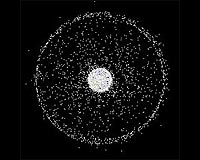 |
Austin TX (SPX) May 14, 2010 Even astronauts are looking to lessen the load in their carry-on luggage these days, and University of Texas at Austin aerospace engineering alumnus Terry Hill (B.S. '96, M.S. '98) is helping them pack a little lighter. As engineering project manager for the Constellation Space Suit System at NASA, Hill is head of the team designing a new versatile spacesuit that can adapt to whatever function is necessary. "It's like picking one outfit from your closet and using it for everything from scuba diving to rock climbing," Hill said. "It's cramming three suits into one." The spacesuit design is one component of the Constellation Program, the project that aims to take humans back to the moon and, hopefully, on to Mars. "It's Apollo on steroids," Hill said. "The ultimate goal of the program is to develop an exploration architecture that will allow us to explore our solar system." That includes building the space capsule that will carry astronauts to the space station, a heavy rocket and lander for lunar habitat, and the launch vehicle for Mars. What makes the spacesuit design challenging is the different modules that can be removed and replaced so that it can be used for everything from launching to spacewalks to moonwalks. "Historically, the suits have followed the function they were designed for, and they were designed for a specific task or environment," Hill explained. The orange suits that crews wore during launch, which protect them from pressure changes and hypothermia in the event of a bailout, couldn't be worn when it came time to work outside the shuttle on a space station repair. And the bulky white Extra Mobility Unit suits that allowed Apollo astronauts to walk on the reduced-gravity surface of the moon are not appropriate for day-to-day living in the space capsule. But with the new suit in progress, Hill said, "You can reconfigure what you need to once you get into orbit. Once you get to the moon, you snap off the arms and legs and put them on a different torso and put on your helmet, and you're ready to go." Having one suit that meets all purposes requires thinking outside the box and finding innovative ways to fashion pieces that can snap on and off. Hill credits his experiences at the university with teaching him to solve problems that no one has encountered before. "Some of the projects the professors gave you didn't have a solution and they're making you come up with creative ways to solve a problem," he said. "There's no one to turn to for an answer. You have to figure it out." He said the broad engineering background that an aerospace degree provides makes that problem-solving possible. "To get things into the air, you have to optimize them to fly within a hair, and that gave me a very good engineering background to lead a team where optimizing all systems was critical," he said. The difficulty of the aerospace program also taught him never to give up. "I had some really tough low points during my career at UT, and what it taught me was perseverance," Hill said. "You stick it out. You pull in your resources, you regroup and push forward." That tenacity has enabled Hill to keep pushing forward on the spacesuit design and to work on other successful projects at NASA since leaving the university. After earning his bachelor's degree in aerospace engineering in 1996, he went on to get his master's degree in Aerospace Guidance Navigation and Control Theory in 1998. Having begun a co-op with NASA in 1997, he was hired on full-time in 1999 and has been there ever since. "NASA was the mecca of engineering," Hill said. "I never thought I'd end up there." Hill originally dreamed of being a pilot when he was in high school, so he figured an aerospace engineering degree was the best degree to work toward in case his dream didn't work out. But somewhere along the line, he became captivated with aerospace engineering and never turned back. "I was enthralled with space travel and the ability for us to figure out these kinds of problems," he said. Although where exactly the new administration wants to send astronauts next is uncertain, Hill said his team's project is essential for any destination. "If they're sending humans up there," he said, "then they've got to have space suits."
Share This Article With Planet Earth
Related Links University of Texas at Austin Space Tourism, Space Transport and Space Exploration News
 Chaotic space traffic needs rules, less secrecy: US general
Chaotic space traffic needs rules, less secrecy: US generalWashington (AFP) May 13, 2010 A top US general on Thursday called for international rules to control chaotic space traffic, warning satellites are increasingly at risk of collision. General James Cartwright, vice chairman of the Joint Chiefs of Staff, said it was no longer possible for the United States and other countries to keep vast numbers of orbiting satellites a secret. "We're going to have get to some level of ... read more |
|
| The content herein, unless otherwise known to be public domain, are Copyright 1995-2010 - SpaceDaily. AFP and UPI Wire Stories are copyright Agence France-Presse and United Press International. ESA Portal Reports are copyright European Space Agency. All NASA sourced material is public domain. Additional copyrights may apply in whole or part to other bona fide parties. Advertising does not imply endorsement,agreement or approval of any opinions, statements or information provided by SpaceDaily on any Web page published or hosted by SpaceDaily. Privacy Statement |